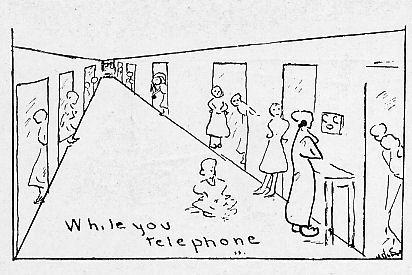Kathy Graneggen Moberg '79 and Catherine Walsh Davis '70, '76
With the 100th anniversary approaching, the Martha Cook Building continues to look like the same dormitory York and Sawyer and the Hayden Company originally created and the one we all remember from our college days. The early 20th century era ambiance is intact, even as it meshes with 21st century student life. However, the beauty and functionality of MCB have continued to the present in part through careful and necessary changes which are a facet of good stewardship.
Window screens were an early upgrade in 1918! Edward York reported to William Cook in March of that year, that the residents requested screens for the upper floor windows because the flies and mosquitoes were "troublesome". The dining room chairs were re-caned and repaired countless times until their replacement in 2009 with new, sturdier chairs that closely replicate the originals. The kitchen has regularly needed to replace and upgrade dishes and equipment (including a new walk-in refrigerator/freezer in the summer of 2005) to maintain efficient service and keep up with current food safety regulations. The tradition of ice-cream as a frequent menu item changed quite spectacularly in 2010with the purchase of a soft serve ice-cream machine such as other dining halls on campus have had since the 1970's!
Some of the physical changes and upgrades to the Building have been less noticeable but were more significant in terms of safety and cost. Prior to fall 1958, the elevator required a human operator to move it from floor to floor (it only operated between 7:30 am and 9 pm in 1937), and residents who worked part time in this position earned a small wage (25 cents per hour in the 30s). The new elevator of 1958, while still capable of being manually operated, was high tech for its time and worked automatically. Today's main elevator, installed in 1999, has the added features of sound and signage for the vision-impaired. In addition, a small elevator, rising inconspicuously from the old coat room area to the main hall, was installed in 1995 and provides handicapped access to the central part of the Building.
While MCB was touted as practically fire proof in 1915, we know this is untrue. We have not documented when the first fire alarm was installed but we know that MCB has made it a priority to keep up with improvements in fire safety. One of the major accomplishments of Director Olive Chernow '47, MSW '53 was to revamp the entire system, beginning with a full inspection in August 1973. It took until November 1976 to complete the multipart job which included new combustion detectors on all floors, an elevator alarm and a fire extinguishing system for the kitchen. The system was upgraded again in the summer of 2001 with a $535,000 state-of-the-art alarm. It is astonishingly sensitive and includes flashing lights as well as sound. Fire suppression (sprinklers) and mass notification systems were added in summer 2013.
The Martha Cook Building's telephone system has changed with the times, too. When the Building opened, there were 7 phones; 1 each on the 2nd, 3rd and 4th floors, and in the office, social director's bedroom, cloak room and the kitchen. A switchboard was a feature in the front office until June 1975 when Centrex system phones were installed in rooms or single suites, and it was carted off to "star" as a prop in a University Players production of Hot'l Baltimore! We do not know what became of it since. In 1996, the wall-mounted phones were replaced with desk phones, and each room in a single suite had its own. As computers and the internet became increasingly central to academic life, Ethernet was also installed in all rooms in '96, and the Building went wireless in 2010. Residents may now sit anywhere in MCB and work on their laptops without needing to find an outlet. The first residents would have considered a manual typewriter a luxury!
Change in the Martha Cook Building is often subtle or even invisible to the eye. It keeps us safe and current and when done with care, it enhances our tradition of gracious living.

